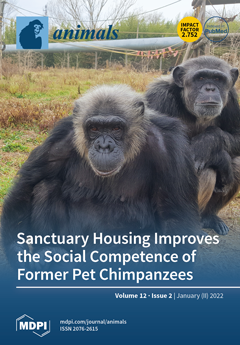Five natural historic cheeses of Southern Italy were investigated—
Caciocavallo Palermitano (CP),
Casizolu del Montiferru (CdM),
Vastedda della Valle del Belìce (VVB),
Pecorino Siciliano (PS), and
Caprino Nicastrese (CN)—which are produced with raw milk and with traditional techniques and tools, from autochthonous breeds
[...] Read more.
Five natural historic cheeses of Southern Italy were investigated—
Caciocavallo Palermitano (CP),
Casizolu del Montiferru (CdM),
Vastedda della Valle del Belìce (VVB),
Pecorino Siciliano (PS), and
Caprino Nicastrese (CN)—which are produced with raw milk and with traditional techniques and tools, from autochthonous breeds reared under an extensive system. The effects of the month of production on gross composition, MUFA, PUFA, PUFA-ω6, PUFA-ω3, α-tocopherol, retinol, cholesterol, TPC, TEAC, and GHIC were evaluated. In CP, CLA, TPC, and GHIC were higher in April than in February. CdM showed higher values in terms of fat, saturated fatty acids, PUFA-ω3, α-tocopherol, TEAC, and GHIC in May than in February and September, while low values in terms of protein, moisture, and CLA were found. In VVB, MUFA, PUFA-ω6, and α-tocopherol increased in June compared with April; conversely, protein, FRAP, and TEAC were higher in April. In PS, protein, CLA, PUFA, PUFA-ω3, α-tocopherol, and GHIC increased in May compared with January; on the contrary, moisture, NaCl, and TEAC showed high values in January. CN showed higher values in terms of PUFA, PUFA-ω6, PUFA-ω3, TPC, TEAC, and GHIC in April and June compared with January. It is shown that each cheese is unique and closely linked to the production area. Cheeses produced in the spring months showed a high nutritional quality due to the greatest presence of healthy compounds originating from an extensive feeding system.
Full article






